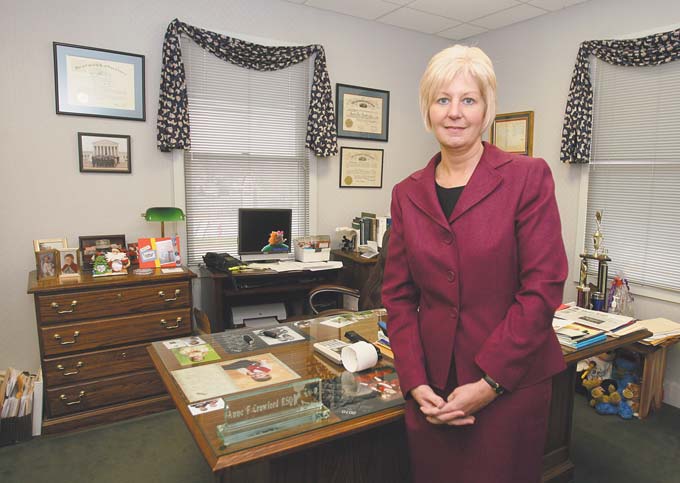Celebrating life


Atty. Anne Frederick Crawford of Canfield suffered from epileptic seizures most of her life until having brain surgery at the Cleveland Clinic Epilepsy Center in 1999. The surgery stopped her seizures and enabled her to have a normal life.
Surgery gave epilepsy patient a chance at career, children
YOUNGSTOWN
Atty. Anne Frederick Crawford celebrates Oct. 14 as if it was the day her life began, and in a sense, it was.
At 9 months, Crawford, 48, had a convulsion that left a scar on her left temporal lobe that instantly left her subject to epileptic seizures.
Fast forward to Oct. 14, 1999.
Crawford underwent brain surgery to remove the scar leaving her seizure-free “from day one. I was very lucky. The doctors were able to pinpoint the location and cause of my epilepsy [the scar],” she said.
The celebration this year was at Disney World with her husband, Scott, and children, Scotty, 7, and Kara, 21/2, who she says are her miracles.
“I was not willing to chance pregnancy” had the surgery, amygdala-hippocampectomy, not been successful, she said.
The side effects’ trade-off from the surgery is difficulty in remembering dates, times, places and names.
Nonetheless, she said she would do the surgery again tomorrow.
“It opened the door to having a family and a career,” said Crawford, a 1981 graduate of Canfield High School who received bachelor’s and law degrees from Ohio Northern University.
“There are worse things in life than not remembering names and dates.”
Crawford’s rebirth also led to what she described as “my calling to the elderly” in her law practice, which consists primarily of estate planning, guardianships and trusts, and in her private life.
She can empathize with older people “because I know what it’s like to not remember everything,” said the former trial lawyer who once had a seizure during a trial.
While he was alive, her father, Atty. Harry Frederick, was her “second chair” and had her back when she was the case lead attorney. And before her mother, Ellen, a 27-year cancer survivor, died, she got her wish of seeing her daughter seizure-free.
But, between seizure-free and seizure-prone was a long, bumpy road that was a trial for Crawford and those close to her.
She resents the branding that goes with epilepsy.
While a litigation attorney, she did not tell her fellow attorneys about her epilepsy, believing they would have treated her differently had they known. She thought they would have been more cautious around her.
“An attorney’s reputation, in and out of the courtroom, is earned. I didn’t want to earn mine out of pity. I wanted to be judged by my work,” she said.
She was on medication to control her seizures when she got married in 1997.
“Relationships are not simple. You need a special person to understand. I had a seizure on our second date,” she said.
Crawford said she hid her seizures well as a youth, in college and in the work world.
“I was very lucky. I’d get an aura — coffee not tasting right was my first clue — warning me things might go south and to get someplace else and hug my teddy bear,” she said.
“Every kid who goes through this needs a teddy bear. When I had a seizure, I held him tightly. It kept my arms occupied and stopped my jaw from chattering,” she said.
Crawford used several anti-seizure medications over the years but the side effects were becoming intolerable and the medications sometimes ineffective.
Then Dr. Robert Gilliland, a local neurologist, came into her life.
He told her about new medications that were available and after some trial and error, they found Felbatol.
“It was the best drug in the world, at least for me. I was very functional. The death rate with Felbatol was increasing but I didn’t care. I was willing to sign any release to stay on the drug,” she said.
Then in 1998, the seizures began again.
Dr. Gilliland told her and her husband about a young doctor, Dr. Imad Najm, now director of the Cleveland Clinic Epilepsy Center, as someone who could determine if she was a candidate for surgery.
She was, and successful surgery was performed by Dr. William Bingaman of the Epilepsy Center.
Surgery is not for every-one, but anybody with epileptic seizures should investigate what medicines and treatment options are available and what might work for them, she said.
Crawford said a good source of information and help for people with epilepsy is the Mahoning Valley Epilepsy Fund in Austintown.
The Epilepsy Fund is sponsoring a program Saturday called “K.I.D.S. Knowledge in Dealing with Seizures,” at the Austintown Public Library, 600 S. Raccoon Road. To register, call 330-270-8037.
Crawford is a patient advocate.
“I think I’m able to see where people want to go with their treatment and help get them there. My rule is, I don’t care where you go. There are medications and other choices out there, and if you don’t like what you’re hearing, go somewhere else.”
To others who are in the position in which she found herself, Crawford said, “Life is short. If you don’t like the cards you were dealt, change them.”
At the same time, she suggests people with epilepsy not feel too sorry for themselves.
“Sit in the waiting room at a Pittsburgh or Cleveland hospital and see the problems other people face. I almost feel guilty sitting there.
“Epilepsy is tough for the moment, but it is not the worst thing in the world,” she said.
 43
43
